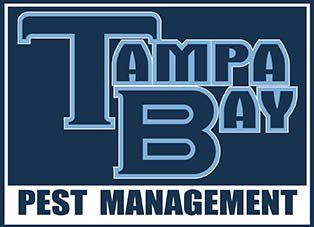Ant Pest Control in Tampa Bay, FL
Below is a list of ants you may find in your Florida home or business.
ACROBAT ANT
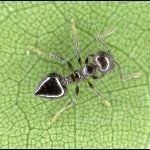
Acrobat Ants earned their name from the peculiar habit of raising the abdomen over the head and thorax (chest). They are found throughout the United States, particularly in old tree stumps, underneath stones, and other similar areas. Acrobat ants forage very well and will readily enter homes in search of food. They will use any source available to enter homes including power lines, tree limbs, and shrubs. Acrobat ant workers are generally black, light brown, or multi-colored and are about 2-4 mm in size.
ARGENTINE ANT

Pharaoh Ants are one of the most difficult ant species to control. They can be found in all types of buildings, but have become a particular problem in hospitals because of the multiple types of bacteria that they carry. They enter into structures and buildings through small cracks and other openings. Pharaoh ants are extremely small, though not quite as small as Ghost ants, and very slow-moving as well. The workers are approximately 1/16 of an inch in length and range from light brown to reddish in color.
Pharaoh ant queens are capable of producing up to 12 eggs per day that will hatch every 7 days. Their typically life span is about 9 – 10 months. They are normally found in kitchens and bathrooms, but prefer to make their nests in warmer locations such as wall voids, heating systems, and around hot water pipes.
BIG-HEADED ANT
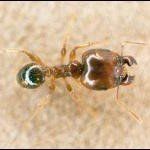
Big-Headed Ants are native of South Africa and are known for forming very large infestations with multiple queens. They nest in and around homes and forage indoors. Once indoors, they can often be found trailing near the baseboards under the carpeting. These ants are normally found in warmer climates. Big-headed ant colonies consist of two worker forms, small and large. The small workers are typically 1½ – 2½ mm in length while the large workers are 2½ – 3½ mm in length and have a very large head disproportionate to the body.
CARIBBEAN CRAZY ANT
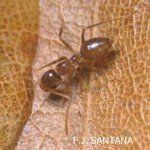
Caribbean Crazy Ants are native to the Caribbean Islands. Like the Crazy ant, they earned their name from erratic, rapid, and random movement when disturbed. There have multiple queens in every colony that are easily identified due to their bigger size. These ants are only about an eighth inch in length and all the workers are the same size. These ants are well known for foraging in trails that are at least 3-ants wide and are usually seen in extremely high volumes.
CRAZY ANT
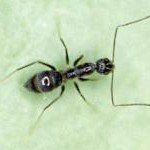
Crazy Ants earned their name from their characteristic of erratic and rapid movement. Crazy ants are generally found in tropical climates, particularly in the southeastern region. Their adaptation skills are very strong and can live in both dry and moist habitats. During the winter, they will forage and nest inside apartments, homes, and buildings.
Crazy ants have a wide diet range consisting of live and dead insects, fruits, seeds, and honeydew. The workers are known to gather seeds from seed beds of lettuce and tobacco crops. They usually prefer more of a high-protein diet during the summer months. Crazy ants can grow their colonies from a moderate size to extremely large and can raise their young at any time of year in warmer climates.
Crazy ant workers are typically about 2½ – 3 mm long. The head, thorax (chest), and abdomen are dark brown to almost black in color. They are very long-legged, like the Florida carpenter ant, and are also very slender.
FLORIDA CARPENTER ANT
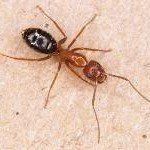
Florida Carpenter Ants are a long-legged, swift-moving ant that will occasionally forage into homes or buildings looking for food and nesting sites. These ants are very large, reddish-brown to black, and are typically about ¼ – ½ inch in length. The workers range in size from 4 – 9 mm. They are capable of inflicting a painful bite but are typically not very aggressive.
Florida carpenter ants prefer to nest in wood that has been damaged by termites or decay but can also tunnel through sound wood. These ants do not eat the wood but excavate galleries in it to rear their young. They remove the wood in the form of coarse sawdust. This ant species can establish nesting sites in a variety of locations such as rotten stumps, dead limbs of trees, and underneath logs.
Carpenter ants feed on a variety of plant and animal materials, small insects, and honeydew from aphids and scales. They are well known for being able to forage up to 100 yards in search of food and usually begin this process around dusk. Dusk or shortly after is the best time to search for their nests, and following their trails is the best approach.
GHOST ANT

Ghost Ants are an extremely small ant species. The workers are only about 1/20 of an inch in length. While the head is usually dark in color, the remainder of the body including the thorax (chest) and abdomen are milky white which is where they earned their name.
The Ghost ant is not typically found in the northern states, especially in the wintertime, due to its inability to establish any colonies. The vast majority of this these ants are found in the south and particularly in South Florida. Ghost ants readily enter homes and buildings through hairline cracks in stucco, brick, or block and also through poorly caulked windows. They are usually found near water areas in either kitchens or bathrooms.
RED IMPORTED FIRE ANT
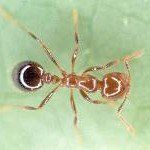
Red Imported Fire Ants - There are two species of imported fire ants, the red imported fire ants, and the black imported fire ants. The red imported fire ants currently infest a much larger area in the southeastern states than the black imported fire ants. They are usually found in sunny open areas such as pastures, roadsides, lawns, parks, and mulch areas. Red imported fire ants are usually about 3 – 6 mm in length, reddish brown in color, and build mounds that can be as much as 2ft tall and 3ft in diameter. Heavily infested areas will usually have as many as 20 – 30 colonies/mounds per acre. Imported fire ants are small, aggressive ants, and their sting causes painful, burning pustules that may take up to ten days to heal.
WHITE-FOOTED ANT
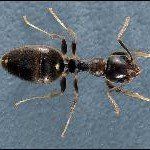
White-Footed Ants have become a major household pest in recent years. These ants closely resemble the Argentine ants and the Crazy ants but can be separated by their distinct milky-white feet and they do not move nearly as quickly. White-footed ants are commonly found foraging along branches and trunks of trees and shrubs. They feed on plant nectars, honeydew, and other sweet substances produced by aphids and scale insects.
White-footed ants nest at or above the ground level. They prefer nesting sites that are near food and moisture sources. Once they have found their way indoors, they build satellite nests in wall voids and attics. These ants are typically about 2½ – 3 mm in length and dark brown to almost black in color. They are not aggressive, do not bite or sting, and cause no damage to structures.
Call Us Today for a FREE Ant Pest Service Estimate
